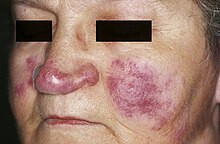Lupus pernio
| Lupus pernio | |
|---|---|
 | |
| Cutaneous lesions of sarcoidosis (lupus pernio). Red-to-purple indurated plaques and nodules affecting the nose and cheeks. | |
| Specialty | Dermatology |
Lupus pernio is a
Signs and symptoms
The hallmarks of lupus pernio are violaceous or erythematous, indurated plaques that are mostly found on the cheeks and nose in the center of the face. Rarely, lesions may also affect the dorsum of the hands and feet and the ears.[3] The symptoms of lupus pernio range from a few tiny nodules on the nose to vibrant plaques that cover both cheeks.[4] Lupus pernio lesions begin slowly but eventually penetrate and indurate into the underlying bone and cartilage, resulting in deformity.[3] There is a higher chance of extracutaneous involvement, especially in the respiratory tract, in lupus pernio.[5]
Causes
The cause of cutaneous sarcoidosis is still not fully known. The generally acknowledged theory proposes that a complex interplay among genetic predisposition, immunological dysregulation, and environmental factors leads to sarcoidosis.[3] It is believed that an augmented cell-mediated immune response to one or more undiscovered antigens is the cause of the granulomatous inflammation.[6] Environmental exposure may have a role in the etiology of sarcoidosis, as evidenced by the development of granulomas that resemble sarcoid granulomas after exposure to metals such beryllium, zirconium, and aluminum.[3] A number microorganisms have been suggested as potential etiologic agents of sarcoidosis, most notably mycobacteria and cutibacteria (previously propionibacteria).[7]
See also
- Sarcoidosis
- Skin manifestations of sarcoidosis
- List of cutaneous conditions
References
- ISBN 978-1-4377-0314-6.
- ISBN 978-1-4160-2999-1.
- ^ PMID 30725653. Retrieved 2024-02-24.
- ISSN 0961-2033.
- PMID 2983750.
- PMID 18539232.
- ISSN 1080-0549.
